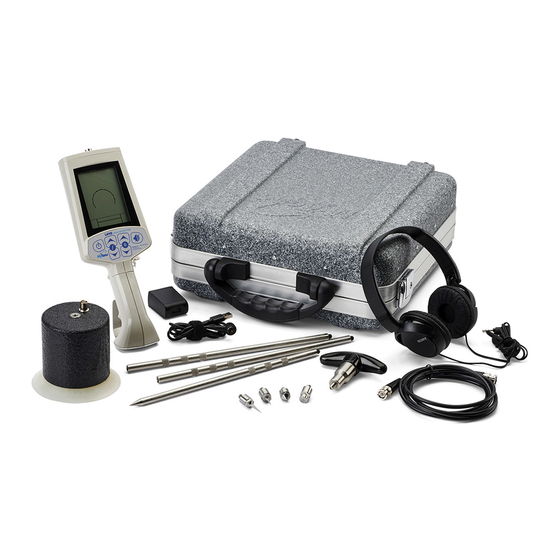
Advertisement
Quick Links
Inspect your system carefully upon receipt.
Let us know right away of any damage you note.
Display/Digital
Response Meter –
5 Frequency bands,
GAIN control
mute switch
Sensor –
a low-noise amplifier
which outputs sound
signal to both meter
and headphones.
Experience leads to a skill level
where leak location specialists
are able to identify leaks by their
acoustic noise "signature". Even
experienced personnel are contin-
ually increasing their skill level and
improving their techniques.
082919
Manufacturers of Quality
Sewer & Drain Cleaning
Equipment since 1957
LD40 User Manual
Recharging
cable and
connector
Sensor
Sensor probe
handle
extension
extensions
Introduction
Using technology originally developed for the nuclear power industry, the LD40 has
been modified specifically to pick-up acoustic signals and frequencies commonly
encountered in plumbing, water and sewer applications.
The acoustic signal characteristics of leaks vary considerably from one leak to
another, even when the leaks have similar water pressure and water leak rate. In
some cases, it will be definitely known that there is a leak in a segment of pipe but
there will be no visible indication of the specific area of the leak.
Since leaks have a variety of sounds, it is strongly recommended you
• Practice with the LD40 on known leaks to gain an understanding of how the
unit processes those sounds.
• Do an initial mapping of the search area for a leak-type signal. After initial
detection of a leak signal, use the other frequency bands to find the best signal
with the least interference from environmental background noise.
www.MyTana.com
746 Selby Ave • St. Paul MN, 55104
fax: 651.222.1739
Carrying Case
4 sensor tips –
Sensor or
use on variable
extension
surfaces
handle
Headphones
with
connecting
cord
Sensor connection
cord
1.800.328.8170
Factory Direct Customer Service
M –F 7am – 5pm CST
Competent • Polite • Clear
Advertisement

Subscribe to Our Youtube Channel
Summary of Contents for MyTana LD40
- Page 1 Since leaks have a variety of sounds, it is strongly recommended you • Practice with the LD40 on known leaks to gain an understanding of how the unit processes those sounds. • Do an initial mapping of the search area for a leak-type signal. After initial detection of a leak signal, use the other frequency bands to find the best signal with the least interference from environmental background noise.
- Page 2 USB end to frequencies (see steps 3-5 next page) the charging port and plug in to wall socket. Power Button The LD40 is powered by a lithium-ion battery. Battery charge is indicated in the lower Other equipment you may need: left corner of the display.
- Page 3 PG 3 MY TANA LD40 USER MANUAL Getting Started 1. Switch on and mute the headphones. 2. Set the frequency band to broadband (B) using the button 3. Set the GAIN completely down using the button. 4. Set the sensor on the floor surface to be monitored for leaks. The sensor tip should be contacting the surface.
- Page 4 PG 4 MY TANA LD40 USER MANUAL Indoors Additional Tips In a building, readings taken on all angle stops, faucets, exposed pipe, hose bibs etc. will help make a “map” of signal intensity. Often all points will have detectable signal •...

Need help?
Do you have a question about the LD40 and is the answer not in the manual?
Questions and answers